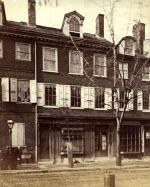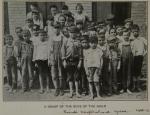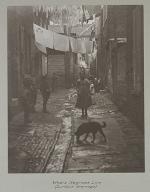![header=[Marker Text] body=[Founded in 1846, this was Pennsylvania's first such institution.Irish Catholics, other immigrants, and native-born were its constituency. Services to the needy included training programs for persons seeking work, designed to encourage their ultimate independence.] sign](http://explorepahistory.com/kora/files/1/10/1-A-3D3-139-ExplorePAHistory-a0n2g1-a_450.jpg)
Mouse over for marker text
Name:
House of Industry
Region:
Philadelphia and its Countryside/Lehigh Valley
County:
Philadelphia
Marker Location:
714 Catherine St., Philadelphia
Dedication Date:
June 27, 1996
Behind the Marker
In many respects, Philadelphia's  1844 anti-immigrant violence and the creation of a neighborhood center two years later to assist the urban and immigrant poor represent two different responses to the influx of newcomers in mid-nineteenth century Philadelphia. Opened by the Philadelphia Society for the Employment and Instruction of the Poor, the "House of Industry" was one institution designed to assist the working poor in their movement into the social mainstream.
1844 anti-immigrant violence and the creation of a neighborhood center two years later to assist the urban and immigrant poor represent two different responses to the influx of newcomers in mid-nineteenth century Philadelphia. Opened by the Philadelphia Society for the Employment and Instruction of the Poor, the "House of Industry" was one institution designed to assist the working poor in their movement into the social mainstream.
In an age of heightening immigration and growing class tension, this local institution served the interests of employers, who sought a trained work force, and the interests of laborers who sought job security in the changing economy of the Mid-Atlantic region. A direct response to local developments, the House of Industry was also a precursor to the American settlement house movement of the late 1800s.
As America's second largest port city, Philadelphia was a mecca for foreign-born immigrants, and native workers. Despite its rapidly expanding manufacturing economy, the city was experiencing an alarming growth in the number of people living in poverty, and in homelessness, alcoholism, disease, and crime.
Even as the city began to recover from the devastating economic depression of the 1830s, social tensions among immigrant groups and between established residents and newcomers rocked the urban landscape. Most noticeable were the Kensington riots of May and July 1844, and the impoverished neighborhoods of Southwark. The subsequent arrival of tens of thousands of Irish immigrants following repeated failures of the potato harvest exacerbated existing conditions. Ethnic and religious prejudice made more complicated the pervasive poverty of the working class.
Located at 7th and Catherine Streets, the House of Industry provided a more constructive and pragmatic alternative to street clashes and urban warfare. Long before settlement houses were popular, this neighborhood center offered those unable or unprepared to make their own way-natives and newcomers alike-temporary shelter, food, job training, English-language courses, and other practical programs. At first its clients included Irish and German immigrants, but by the turn of the twentieth century, the House also was serving the growing number of Southern- and Eastern-European immigrants, including Italians, Poles, Slovaks, Jews, and African Americans, as well. As neighborhoods changed, so too did the client base.
By the late 1800s, the House of Industry had been joined by more than two dozen urban centers and settlement houses scattered throughout Philadelphia. Like Chicago's Hull House (1889), the House of Industry reflected both the practical and humanitarian aspects of reform in the industrial age. Day care, English-language instruction, the rudiments of job training and housing assistance were all part of the settlement-house agenda. Advocates addressed issues of urban crime and poverty, nutrition, and neighborhood cleanliness. Intended to address the everyday social and economic needs of the immigrant poor, these inner-city centers became powerful agents for social reform.
In Philadelphia and elsewhere, settlement houses affiliated with local church congregations and synagogues, immigrant benevolent associations, and colleges dotted the urban landscape. "Along with nonsectarian agencies," historian Richard N. Juliani noted, "settlements operated under Baptists, Presbyterian, Quaker, Roman Catholic, Methodist, Episcopalian, Jewish, and unspecified, but Christian, auspices."
Following the World War I, the House of Industry joined with several other settlement houses to form the Philadelphia Welfare Federation. In 1946, the organizations merged to create the United Neighbors Association. A further consolidation of resources occurred following a wave of urban riots in the late 1960s.
Created in 1969 in the aftermath of the urban unrest and race riots of the 1960s, the United Communities Southeast Philadelphia continues to advocate for economically disadvantaged groups throughout the region. The organization's agenda includes job training and readiness programs, parenting classes, childcare, household finance-management workshops, and in-home weatherization assistance. United Communities has also championed environmental cleanup and urban restoration projects in southeast Philadelphia.
Although its organizational reach has expanded geographically, and the racial and ethnic composition of its client base has changed, its mission and priority of "helping communities and neighborhood leadership organize themselves" recalls the early reform agenda that the House of Industry pioneered more than 150 years ago.
In an age of heightening immigration and growing class tension, this local institution served the interests of employers, who sought a trained work force, and the interests of laborers who sought job security in the changing economy of the Mid-Atlantic region. A direct response to local developments, the House of Industry was also a precursor to the American settlement house movement of the late 1800s.
As America's second largest port city, Philadelphia was a mecca for foreign-born immigrants, and native workers. Despite its rapidly expanding manufacturing economy, the city was experiencing an alarming growth in the number of people living in poverty, and in homelessness, alcoholism, disease, and crime.
Even as the city began to recover from the devastating economic depression of the 1830s, social tensions among immigrant groups and between established residents and newcomers rocked the urban landscape. Most noticeable were the Kensington riots of May and July 1844, and the impoverished neighborhoods of Southwark. The subsequent arrival of tens of thousands of Irish immigrants following repeated failures of the potato harvest exacerbated existing conditions. Ethnic and religious prejudice made more complicated the pervasive poverty of the working class.
Located at 7th and Catherine Streets, the House of Industry provided a more constructive and pragmatic alternative to street clashes and urban warfare. Long before settlement houses were popular, this neighborhood center offered those unable or unprepared to make their own way-natives and newcomers alike-temporary shelter, food, job training, English-language courses, and other practical programs. At first its clients included Irish and German immigrants, but by the turn of the twentieth century, the House also was serving the growing number of Southern- and Eastern-European immigrants, including Italians, Poles, Slovaks, Jews, and African Americans, as well. As neighborhoods changed, so too did the client base.
By the late 1800s, the House of Industry had been joined by more than two dozen urban centers and settlement houses scattered throughout Philadelphia. Like Chicago's Hull House (1889), the House of Industry reflected both the practical and humanitarian aspects of reform in the industrial age. Day care, English-language instruction, the rudiments of job training and housing assistance were all part of the settlement-house agenda. Advocates addressed issues of urban crime and poverty, nutrition, and neighborhood cleanliness. Intended to address the everyday social and economic needs of the immigrant poor, these inner-city centers became powerful agents for social reform.
In Philadelphia and elsewhere, settlement houses affiliated with local church congregations and synagogues, immigrant benevolent associations, and colleges dotted the urban landscape. "Along with nonsectarian agencies," historian Richard N. Juliani noted, "settlements operated under Baptists, Presbyterian, Quaker, Roman Catholic, Methodist, Episcopalian, Jewish, and unspecified, but Christian, auspices."
Following the World War I, the House of Industry joined with several other settlement houses to form the Philadelphia Welfare Federation. In 1946, the organizations merged to create the United Neighbors Association. A further consolidation of resources occurred following a wave of urban riots in the late 1960s.
Created in 1969 in the aftermath of the urban unrest and race riots of the 1960s, the United Communities Southeast Philadelphia continues to advocate for economically disadvantaged groups throughout the region. The organization's agenda includes job training and readiness programs, parenting classes, childcare, household finance-management workshops, and in-home weatherization assistance. United Communities has also championed environmental cleanup and urban restoration projects in southeast Philadelphia.
Although its organizational reach has expanded geographically, and the racial and ethnic composition of its client base has changed, its mission and priority of "helping communities and neighborhood leadership organize themselves" recalls the early reform agenda that the House of Industry pioneered more than 150 years ago.
Beyond the Marker








